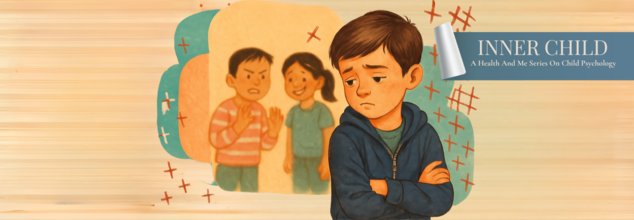- Health Conditions A-Z
- Health & Wellness
- Nutrition
- Fitness
- Health News
- Ayurveda
- Videos
- Medicine A-Z
- Parenting
- Web Stories
Inner Child: When the Bullied Turns Into A Bully – Psychology Of A Victim’s Defense Turned Attack

‘Inner Child’ is Health and Me's new mental health series where we deep dive into lesser-known aspects of child psychology and how it shapes you as you grow up. Often unheard, mistaken, and misunderstood, in this series we talk about the children’s perspective and their mental health, something different than you might have read in your parenting books. After all, parenting is not just about teaching but also unlearning.
Children may not know the concepts of self-esteem and self-worth, but they understand and own the things they are told, even at a very young age. “Growing up, I was not the brightest student in class, and it was something teachers, my classmates as well as adults in my life used to constantly hold against me. I found, rather than helping me be better, my teachers focused more on painting me as the ‘worst kid in class’.” Radha opened up about her first experience with bullying, explaining how the people who should’ve made her feel stronger and worthwhile, turned into her first bullies.
“If I was going to be vilified for my lack of studying capacity, I’m no longer keeping quiet. I started talking back to my teachers and the kids who used to eco their words. I just built a guard around myself, that would only come down for a few friends. I knew I was a victim and should have been treated better. My friends agreed with me, helping me realize my own self-worth.” Coming to the understanding and re-learning to love herself wasn’t easy, but Radha was determined to find the strength in herself.
“I had grown and felt I that I had been doing much better, noticing people around me, I didn’t care if they thought of me rude or worthless, because I knew myself. But did I? It was not until I was called out one day by my closest friend, that I realized I had done the same thing I despised others for doing to me. I found that in my journey of standing up to my bullies, I had turned into one to a girl in my class, who was nothing but kind to me and others. Looking back, while I thought I was defending myself, I ended up hurting someone who could not stand up to me.”
Bullying And Formative Years of A Child
Teenage bullying can deeply affect everyone involved, not just the victims. Understanding why some teens become bullies could help us recognize signs and get them better help. Speaking to Healthandme, Manvi Khurana, Founder, CEO and Senior Counselling Psychologist at Karma Care, we delved into the deeper psychology of how bullies turn into who they are and where they are victims themselves.
Empty Space Inside: What Drives a Bully?
Bullying isn't usually random. Therapist Manvi Khurana explains it often comes from a place of personal struggle and a strong desire for control. She notes that what kids are going through in their own lives often shows up in other ways, like bullying. It's often about trying to "fill a void" or an empty space inside them.
"What are they trying to fill? What discomfort are they showing this way?" This might be a need to feel powerful by putting someone down, or to look tough, especially in a group. Things that can create this "void" include:
- Abuse or trauma at home
- Family problems
- Trouble in school with grades or learning
- General stress
Even without deep trauma, Khurana says some kids become bullies because they feel too entitled or haven't been taught "no" at home. Their upbringing can shape their behavior, even if it's not from a traumatic past.
Basically, bullies often target those who don't fit in or aren't considered "normal." This is why education is so important—it helps people understand and accept differences, making them more common and less likely to be targeted.
From Victim to Bully
A tough part of bullying is when someone who was once a victim later becomes a bully themselves. This makes us wonder if there are similarities between how a victim thinks and how a bully thinks.
Khurana clarifies that a "victim mentality" often means someone always feels like they're suffering, even when they're not at the center of a problem. But with kids, there's good news: "Children's behavior is much more capable of change than adults," she says. Their minds are still flexible, so a bully doesn't have to be a bully forever. With education and support, they can change.
However, Khurana warns that not every victim becomes a bully. "Everyone responds differently." Some victims might keep their pain inside, perhaps leading to self-harm or eating disorders (which are often about control). Others might show their pain through aggression. How a person copes depends on many things, including their culture.
What Bullying Leaves Behind
A key part of understanding bullying that's often missed is its long-term impact on the victim. Khurana emphasizes that the humiliation and pain from bullying can stay with people for years, leading to:
- Specific fears or feeling paranoid
- Damaged self-worth and self-esteem
- A lack of confidence
Is Bullying a Way to Cope?
Can bullying be a way for someone to deal with their own problems? Khurana confirms that for some, it absolutely can be a coping mechanism. She explains it might be about survival, showing dominance, creating a pecking order, or establishing a position of power. In short, it's a way for some to handle difficult feelings or situations by trying to control others.
Bullying is not a straightforward phase, learning about the ups and downs of it could help us understand why some people venture down this path. It shows how personal struggles, how society works, and the chance for growth all play a part for both victims and bullies. It truly highlights the need for empathy, getting help early, and creating school environments where all children can thrive.
Young Hearts at Risk: Why Heart Attacks Are Striking Indians in Their 30s and 40s

(Credit-Canva)
Heart attacks used to be thought of as something that happened to people in their 60s or 70s. But walk into any cardiac ward in India today, and you’ll see a far younger crowd — men and women in their 30s and 40s. It’s a frightening shift, and one that makes us stop and ask: Why are young Indians suddenly facing such a big heart health crisis?
How Heart Disease Are Evolving?
Indian hearts have always been more prone to heart disease than Western hearts, but what's shocking is that it's appearing so early. Some of this is genetic. South Asians are predisposed to heart disease because of the way our bodies metabolize cholesterol and store fat. But genetics don't tell the whole story about why young people are ending up in emergency wards. It's the perfect storm of today's lifestyles, stress, and neglected health that's driving the issue.
Stress, Work Culture, and Sleepless Nights
Take the manner in which we toil and live nowadays. Long office hours, late-night deadlines, endless commutes, and the need to "hustle" are the norm. Throw in sleepless nights, irregular meals, and a perpetual state of being "on", it's no wonder the heart is strained. Chronic stress raises blood pressure, enhances sugar cravings, and fuels inflammation within the body, all of which speed up heart damage.
Lifestyle choices we don’t think twice about
Sedentary lifestyle, weekend binge drinking, and smoking are other major offenders. Hopping from the couch to swiping into the wee hours isn't only bad for your belly, it also decreases your "good" cholesterol and makes your blood vessels more rigid. Teenagers believe they're too active to be concerned, but the reality is, arteries don't distinguish between 35 and 65. Risk factors silently accumulate over the years until something breaks.
Hidden conditions that worsen it
What's most concerning is when young adults don't take seriously any condition like high blood pressure, high cholesterol and diabetes. Most people don't initiate follow-ups with their doctor when they are supposed to, because they feel "too young" to have these conditions. These "silent but deadly" conditions can reduce the function of the heart for years and have no symptoms. By the time you experience chest pain and/or shortness of breath, it may be too late.
The role of diet and pollution
Diets in India are changing too; traditional food is quietly fading into the background and is being replaced by processed foods, sugary beverages, and snacks heavy in trans-fats. Add to that the increasing incidence of air pollution in our cities, which inflames blood vessels and reduces oxygen supply, and now you also add another layer of risk.
What Can Protect Your Heart?
The scary part about this trend is that it feels sudden. The great thing is that a lot of this is preventable. Simple things, such as sensible meals, exercising every day, going to bed at a reasonable time, and reducing smoking and drinking, do make a difference. Routine health checks even simple blood pressure and cholesterol check in your 30s will get you ahead of any issues.". Stress reduction is no longer a luxury; whether yoga, meditation, or simply keeping the screens off for a bit, your heart requires downtime as much as your mind does.
Heart attacks among young Indians are no longer uncommon headlines; they're an expanding reality. But it doesn't have to be our fate. By paying attention to our bodies, honoring our boundaries, and prioritizing heart health every day, we can rewrite this narrative. Because no 35-year-old needs to be struggling to survive in a cardiac ICU when the issue could have been avoided by making tiny but consistent adjustments.
Beyond BRCA: A Broader Genetic Lens on Breast Cancer

(Credit-Canva)
When people hear about “breast cancer genes”, BRCA1 and BRCA2 are usually the first names that come up. These two genes are important; harmful changes or mutations in them can greatly raise the risk of breast and ovarian cancer.
But the BRCA genes are only a part of the breast cancer puzzle. Thanks to advances in genetic testing, doctors now understand that there are several other genes that can affect breast cancer risk. Looking at this wider set of genes, and not just BRCA, can give patients and families a more complete picture of their health and prevention or treatment options.
Other Genes That Matter
PALB2: This gene works closely with the BRCA2 gene on repairing damaged DNA. Some harmful mutations in PALB2 can raise the risk of breast cancer almost as much as BRCA mutations do. Wemen with these mutations are often offered extra screening.
CHEK2
This gene regulates cell division. Some mutations in the CHEK2 gene can increase the risk of breast cancer, though usually not as strongly as mutations in the BRCA or PALB2 genes. People with CHEK2 mutations may need to start screening earlier (around 40 years of age) or have more frequent mammograms and magnetic resonance imaging (MRIs).
ATM
This gene is involved in repairing damaged DNA. Harmful mutations in the ATM gene can raise breast cancer risk, usually to a moderate degree.
TP53, PTEN, AKT1
Although mutations in these genes are rare in breast cancer cases, they are important, as such mutations not only increase the risk of breast cancer but also raise the chances of other cancers (like stomach, thyroid, or colon). Families with these mutations often need personalized screening plans.
Why These Genes Matters
Looking beyond the BRCA genes has real benefits:
Better screening and prevention
If you carry a high-risk mutation (in the PALB2 or TP53 genes), doctors may recommend breast MRIs every year starting at a younger age (as early as 25–30 years), or even discuss preventive surgery.
With moderate-risk mutations (like in the CHEK2 or ATM genes), you might not need preventive surgery, but extra screening could help catch cancer earlier.
Treatment options
Some genetic changes can affect how a tumor responds to certain drugs. For example, cancers linked to BRCA or PALB2 mutations may respond well to PARP inhibitors, a type of targeted therapy.
Knowing your genetic status can help doctors choose treatments that work best for your cancer type.
Family impact
If you test positive for a mutation, your relatives can also be tested. If they carry the same mutation, they can take steps early, like increased screening or lifestyle changes, to detect cancer early, if it occurs.
Things To Keep In Mind
Uncertain results: Sometimes genetic testing can find a “variant of uncertain significance” or VUS. This means that it’s not clear if the mutation is harmful or not based on scientific data worldwide. These results can be confusing, but most VUS findings turn out not to be harmful over time.
Different risks
Not all gene mutations carry the same level of risk. Some are high, some moderate. Doctors combine genetic results with family history and personal health factors to make recommendations.
Ongoing updates
Science is moving quickly. What’s considered uncertain today may be better understood in a few years. Staying in touch with your doctors and genetic counselors can keep your healthcare plans up to date.
What Can You Do?
Ask about genetic testing if you or your family members had breast cancer at a young age, ovarian cancer, male breast cancer, or multiple relatives with breast, prostate, or pancreatic cancer, ask your doctor about genetic risk and testing.
Don’t stop at testing for BRCA genes: Multigene panels are now widely available and can uncover risks that single-gene BRCA tests may miss.
Get genetic counseling: A trained and BGCI certified genetic counselor can explain what your results mean for you and your family, help manage uncertainty, and guide decision-making.
Stay proactive: Even if you don’t carry a harmful mutation, healthy lifestyle choices and regular screening are powerful tools for lowering the risk of cancer.
The Bottom Line
BRCA1 and BRCA2 genes are only 2 chapters of the hereditary breast cancer story. Genes like TP53, PALB2, CHEK2, ATM, and others also play an important role. Broad genetic testing can give a fuller picture of risk, guide treatment, and empower families to take preventive steps.
Knowledge is power—and by looking beyond BRCA, patients and families can make more informed choices, protect their health, and support one another.
Times Network Health Summit 2025: Panelists Explore Mental Health And Coping In The Age of Pressure

At a recent Times Network Health Summit, a panel of experts explored the mental health challenges facing India’s youth. With increasing pressures from academics, social media, and career expectations, young people are struggling with stress, anxiety, and emotional instability. To have a deeper conversation on this Panelists Major General Vikram Dev Dogra, Dr. Praveen Gupta, Neurologist, and Actor and Wellness Entrepreneur Pooja Bedi, along with our moderator Kalpana Sharma shared insights and practical strategies for coping in an increasingly demanding world.
The Generation of Overload
Major General Vikram Dev Dogra reflected on the differences between his generation and today’s youth. “Today, young people have access to more information, more opportunities, and more distractions,” he said. While this opens doors, it also brings challenges like mental stress, anxiety, and identity struggles. Constant screen time and social media pressure make balance rare, while decision-making and comparison often fuel stress.
Mental Health vs. Mental Illness
Dr Praveen Gupta emphasized that mental health challenges differ from mental illnesses. While mental health struggles affect many young people, clinical conditions require professional care. He noted that stigma and denial often prevent timely intervention, even among educated individuals. He said, "Open dialogue and early awareness are key to preventing crises and promoting long-term well-being."
Building Inner Connections
Panelists talked about the importance of building deep, meaningful connections. Pooja Bedi explained, “Small connections are good, but inner connections, spending time with friends, joining health camps, or even regular meetups, strengthen your mental health network.” These connections improve resilience and emotional adaptability, sometimes adding years to life.
Hobbies, Exercise, and Resilience For Mental Wellness
Developing hobbies and maintaining routines were identified as crucial tools for mental wellness. “When we grow older, routines can become monotonous. Hobbies give your mind something to look forward to daily,” Bedi said. Physical exercise was described as the single most important tool for brain health. Just 50 minutes of activity a day can improve blood flow, enhance cognitive function, and protect against conditions like dementia. Combined with hobbies and social connections, this creates a strong foundation for mental resilience.
Positivity as a Choice
Happiness, the panel emphasized, is a conscious choice. “Positivity is a mindset,” Bedi explained. “Every day, you choose whether to be happy or not. Spreading positivity starts with personal choice.” She also introduced her initiative, Happy Soul, which offers courses, meditations, and practical tools to enhance mental wellness. Interested individuals can visit poojabedi.com for upcoming sessions focused on meditation, manifestation, and personal growth.
The Role of Awareness and Action For Mental Health
The discussion concluded with a reminder that mental health challenges require both awareness and action. Limiting technology, encouraging open dialogue, growing hobbies, exercising, and making genuine social connections are all practical ways to maintain emotional balance. As Dr. Praveen Gupta noted, the key lies in early detection, honest conversations, and building resilience to adapt to life’s changes.
© 2024 Bennett, Coleman & Company Limited

